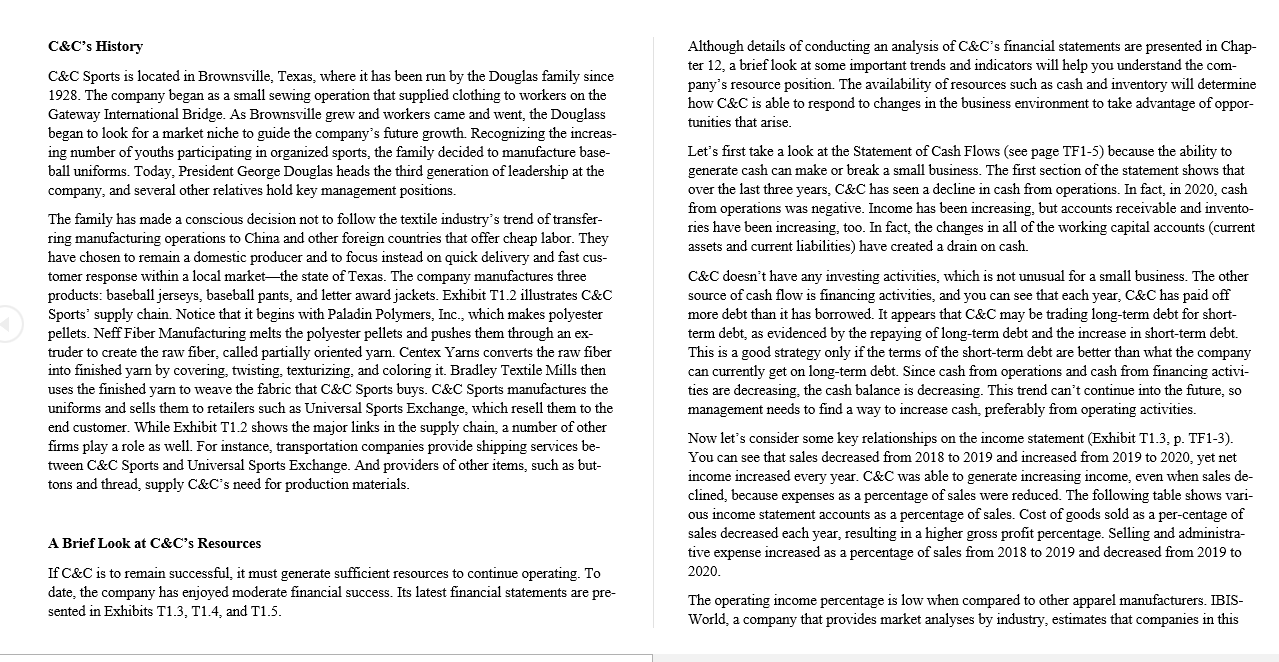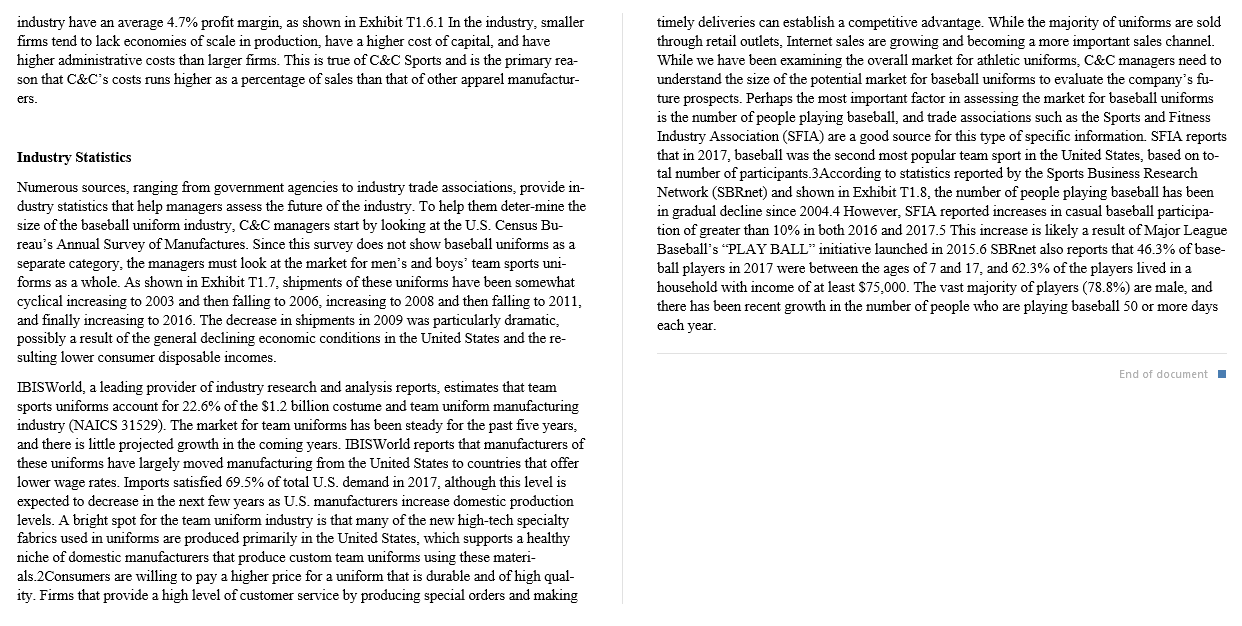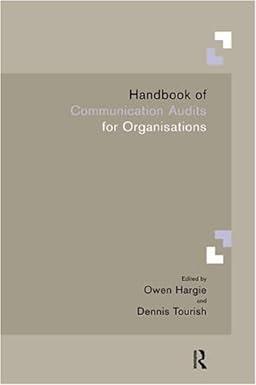Answered step by step
Verified Expert Solution
Question
1 Approved Answer
Do a SWOT analysis (Strengths Weaknesses Opportunities Threats) for C&C Sports based on the materials provided. C&C's History C&C Sports is located in Brownsville, Texas,


Do a SWOT analysis (Strengths Weaknesses Opportunities Threats) for C&C Sports based on the materials provided.
C&C's History C&C Sports is located in Brownsville, Texas, where it has been run by the Douglas family since 1928. The company began as a small sewing operation that supplied clothing to workers on the Gateway International Bridge. As Brownsville grew and workers came and went, the Douglass began to look for a market niche to guide the company's future growth. Recognizing the increas- ing number of youths participating in organized sports, the family decided to manufacture base- ball uniforms. Today, President George Douglas heads the third generation of leadership at the company, and several other relatives hold key management positions. The family has made a conscious decision not to follow the textile industry's trend of transfer- ring manufacturing operations to China and other foreign countries that offer cheap labor. They have chosen to remain a domestic producer and to focus instead on quick delivery and fast cus- tomer response within a local marketthe state of Texas. The company manufactures three products: baseball jerseys, baseball pants, and letter award jackets. Exhibit T1.2 illustrates C&C Sports' supply chain. Notice that it begins with Paladin Polymers, Inc., which makes polyester pellets. Neff Fiber Manufacturing melts the polyester pellets and pushes them through an ex- truder to create the raw fiber, called partially oriented yarn. Centex Yarns converts the raw fiber into finished yarn by covering, twisting, texturizing, and coloring it. Bradley Textile Mills then uses the finished yarn to weave the fabric that C&C Sports buys. C&C Sports manufactures the uniforms and sells them to retailers such as Universal Sports Exchange, which resell them to the end customer. While Exhibit T1.2 shows the major links in the supply chain a number of other firms play a role as well. For instance, transportation companies provide shipping services be- tween C&C Sports and Universal Sports Exchange. And providers of other items, such as but- tons and thread, supply C&C's need for production materials. Although details of conducting an analysis of C&C's financial statements are presented in Chap- ter 12, a brief look at some important trends and indicators will help you understand the com- pany's resource position. The availability of resources such as cash and inventory will determine how C&C is able to respond to changes in the business environment to take advantage of oppor- tunities that arise. Let's first take a look at the Statement of Cash Flows (see page TF1-5) because the ability to generate cash can make or break a small business. The first section of the statement shows that over the last three years, C&C has seen a decline in cash from operations. In fact, in 2020, cash from operations was negative. Income has been increasing, but accounts receivable and invento- ries have been increasing, too. In fact, the changes in all of the working capital accounts (current assets and current liabilities) have created a drain on cash. C&C doesn't have any investing activities, which is not unusual for a small business. The other source of cash flow is financing activities, and you can see that each year, C&C has paid off more debt than it has borrowed. It appears that C&C may be trading long-term debt for short- term debt, as evidenced by the repaying of long-term debt and the increase in short-term debt. This is a good strategy only if the terms of the short-term debt are better than what the company can currently get on long-term debt. Since cash from operations and cash from financing activi- ties are decreasing the cash balance is decreasing. This trend can't continue into the future, so management needs to find a way to increase cash, preferably from operating activities. Now let's consider some key relationships on the income statement (Exhibit T1.3, p. TF1-3). You can see that sales decreased from 2018 to 2019 and increased from 2019 to 2020, yet net income increased every year. C&C was able to generate increasing income, even when sales de- clined, because expenses as a percentage of sales were reduced. The following table shows vari- ous income statement accounts as a percentage of sales. Cost of goods sold as a per-centage of sales decreased each year, resulting in a higher gross profit percentage. Selling and administra- tive expense increased as a percentage of sales from 2018 to 2019 and decreased from 2019 to 2020. The operating income percentage is low when compared to other apparel manufacturers. IBIS- World, a company that provides market analyses by industry, estimates that companies in this A Brief Look at C&C's Resources If C&C is to remain successful, it must generate sufficient resources to continue operating. To date, the company has enjoyed moderate financial success. Its latest financial statements are pre- sented in Exhibits T1.3, 11.4, and T1.5. industry have an average 4.7% profit margin, as shown in Exhibit T1.6.1 In the industry, smaller firms tend to lack economies of scale in production, have a higher cost of capital, and have higher administrative costs than larger firms. This is true of C&C Sports and is the primary rea- son that C&C's costs runs higher as a percentage of sales than that of other apparel manufactur- ers Industry Statistics timely deliveries can establish a competitive advantage. While the majority of uniforms are sold through retail outlets, Internet sales are growing and becoming a more important sales channel. While we have been examining the overall market for athletic uniforms, C&C managers need to understand the size of the potential market for baseball uniforms to evaluate the company's fu- ture prospects. Perhaps the most important factor in assessing the market for baseball uniforms is the number of people playing baseball, and trade associations such as the Sports and Fitness Industry Association (SFIA) are a good source for this type of specific information. SFIA reports that in 2017, baseball was the second most popular team sport in the United States, based on to- tal number of participants.3According to statistics reported by the Sports Business Research Network (SBRnet) and shown in Exhibit T1.8, the number of people playing baseball has been in gradual decline since 2004.4 However, SFIA reported increases in casual baseball participa- tion of greater than 10% in both 2016 and 2017.5 This increase is likely a result of Major League Baseball's PLAY BALL" initiative launched in 2015.6 SBRnet also reports that 46.3% of base- ball players in 2017 were between the ages of 7 and 17, and 62.3% of the players lived in a household with income of at least $75,000. The vast majority of players (78.8%) are male, and there has been recent growth in the number of people who are playing baseball 50 or more days each year. End of document I Numerous sources, ranging from government agencies to industry trade associations, provide in- dustry statistics that help managers assess the future of the industry. To help them deter-mine the size of the baseball uniform industry, C&C managers start by looking at the U.S. Census Bu- reau's Annual Survey of Manufactures. Since this survey does not show baseball uniforms as a separate category, the managers must look at the market for men's and boys' team sports uni- forms as a whole. As shown in Exhibit T1.7, shipments of these uniforms have been somewhat cyclical increasing to 2003 and then falling to 2006, increasing to 2008 and then falling to 2011, and finally increasing to 2016. The decrease in shipments in 2009 was particularly dramatic, possibly a result of the general declining economic conditions in the United States and the re- sulting lower consumer disposable incomes. IBISWorld, a leading provider of industry research and analysis reports, estimates that team sports uniforms account for 22.6% of the $1.2 billion costume and team uniform manufacturing industry (NAICS 31529). The market for team uniforms has been steady for the past five years, and there is little projected growth in the coming years. IBISWorld reports that manufacturers of unif have largely moved manufacturing from the nited States to countries that offer lower wage rates. Imports satisfied 69.5% of total U.S. demand in 2017, although this level is expected to decrease in the next few years as U.S. manufacturers increase domestic production levels. A bright spot for the team uniform industry is that many of the new high-tech specialty fabrics used in uniforms are produced primarily in the United States, which supports a healthy niche of domestic manufacturers that produce custom team uniforms using these materi- als.2 Consumers are willing to pay a higher price for a uniform that is durable and of high qual- ity. Firms that provide a high level of customer service by producing special orders and making
Step by Step Solution
There are 3 Steps involved in it
Step: 1

Get Instant Access to Expert-Tailored Solutions
See step-by-step solutions with expert insights and AI powered tools for academic success
Step: 2

Step: 3

Ace Your Homework with AI
Get the answers you need in no time with our AI-driven, step-by-step assistance
Get Started


